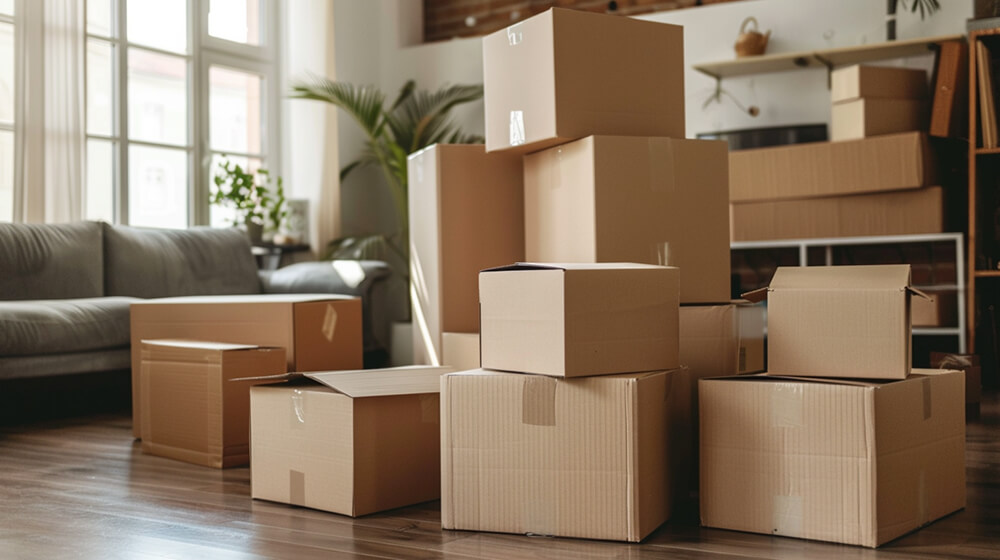
Properly labeling your moving boxes is crucial for an organized and stress-free move. It ensures that your belongings are handled correctly and helps you easily locate items when you arrive at your new home. This guide will cover various labeling methods, from color-coding to detailed inventory lists, to help you manage your move efficiently.
Gathering Supplies
Before you start labeling, gather all necessary supplies:
- Essential Supplies: Permanent markers, labels or stickers, clear packing tape
- Optional Supplies: Label maker, colored tape, fragile labels, large labels for priority boxes, and small containers for miscellaneous items
Having these supplies on hand will streamline the labeling process and ensure that your labels are durable and easy to read.
Choosing a Labeling System
There are several effective ways to label your moving boxes. Choose the method that best suits your needs:
- Color-Coding: Assign a specific color to each room (e.g., blue for the bedroom, red for the kitchen). Use colored markers or tape to label each box accordingly. This visual system helps movers quickly identify the destination room for each box .
- Numbering: Number each box and create a corresponding master list detailing the contents and destination room. This method helps keep track of all items and ensures nothing gets lost during the move.
- Room-Based Labels: Simply label each box with the name of the room it belongs to and a brief description of its contents (e.g., “Kitchen – Utensils”). This straightforward method is easy to implement and understand.
Step-by-Step Guide to Labeling
- Write Clearly and Visibly: Use permanent markers to write large, clear labels. Bold letters and large text improve readability.
- Label All Sides: Label the top and at least two sides of each box to ensure visibility, no matter how the boxes are stacked.
- Include Detailed Contents and Special Instructions: Specify the main items inside and add any special handling instructions (e.g., “Fragile,” “This Side Up”).
- Use Protective Measures: Cover labels with clear packing tape to protect them from moisture and wear during transit.
Special Considerations
- Labeling Fragile Items: Use bright colors or specific labels to mark boxes containing delicate items. Add instructions like “Handle With Care” or “Top Load Only” to prevent damage.
- Prioritizing Essential Boxes: Mark boxes with essential items (e.g., toiletries, important documents) as “Open First” or “Priority 1.” This ensures you can quickly access necessary items upon arrival.
- Labeling Valuables: Clearly label boxes with valuable items and keep them in a secure place during the move. Consider keeping these items with you rather than in the moving truck.
Maintaining an Inventory
Creating a detailed inventory of your boxes helps keep track of all your belongings:
- Master List: Maintain a list with box numbers, contents, and destination rooms.
- Digital Tools: Use spreadsheets or moving apps to manage your inventory. Digital lists are easy to update and can be backed up for safety.
Tips for Efficiency and Organization
- Label Immediately After Packing: Label each box as soon as it’s packed to avoid confusion.
- Consistency: Stick to one labeling method throughout the move to maintain organization.
- Photograph Labels: Take photos of labeled boxes to have a visual backup in case labels get damaged or lost.
Common Mistakes to Avoid
When labeling moving boxes, avoiding common mistakes can save you time and prevent confusion:
- Inconsistent Labeling: Switching between different labeling systems can create confusion and slow down the unpacking process. Stick to one labeling method, whether it’s color-coding, numbering, or room-based labels, to maintain clarity throughout the move.
- Poor Visibility of Labels: Ensure labels are placed on multiple sides of each box and written in large, clear letters. This visibility is crucial, especially when boxes are stacked. Labels that are only on one side or written too small can make identification difficult, leading to frustration during unpacking.
- Overloading Labels with Information: While it’s important to provide details, overloading labels with too much information can clutter them and make them hard to read. Stick to essential details such as the contents, the room it belongs to, and any special handling instructions to keep labels concise and useful.
By avoiding these common mistakes, you can ensure a smoother, more organized move.
Using Technology to Assist in Labeling
Leveraging technology can greatly enhance the efficiency and accuracy of labeling moving boxes:
- Mobile Apps for Inventory and Labeling: Apps like Sortly and Moving Van are designed to help with creating digital inventories and generating labels. These apps allow you to photograph items, assign them to specific boxes, and even create QR codes for easy scanning and identification. This digital approach not only saves time but also helps keep track of your belongings more accurately.
- Printable Label Templates: Many websites offer free, customizable printable label templates. These templates can be personalized with your details and printed out for a consistent and professional look. This can be particularly useful for those who prefer a neat and organized labeling system without handwriting each label.
- Digital Checklists and Backup: Maintaining a digital master list of your inventory can prevent loss and ensure all items are accounted for. Use cloud storage services like Google Drive or Dropbox to store your inventory list. This provides a backup in case physical copies are lost or damaged and allows easy access from any device.
Using these tools can make the moving process more efficient and less stressful, ensuring that your labeling system is both organized and effective.
Final Thoughts
Properly labeling your moving boxes is essential for a smooth and efficient move. By following these guidelines and choosing the labeling system that works best for you, you can minimize stress and ensure your belongings are well-organized and easily accessible. For a hassle-free moving experience, remember to plan ahead, stay organized, and use reliable labeling techniques.


 How to Pack Artwork for Moving
How to Pack Artwork for Moving How to Move a Pool Table
How to Move a Pool Table What to Get Rid of When Moving
What to Get Rid of When Moving How to Pack a TV for Moving
How to Pack a TV for Moving Tips to Handle Moving Stress
Tips to Handle Moving Stress